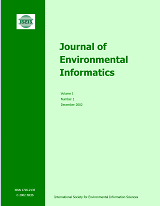© Thomson Reuters Journal Citation Report 2021.
Vol 46, Issue 1 (September 2025)
| Assessment of Climate Change with Remote Sensing Data on Snow and Ice Cover in the Rocky Mountains Glaciers |
PDF
SI
|
| H. Motiee, S. Ahrari, S. Motiee, E. McBean | 1-13 |
| Preparation and Application of Acrylic Polymer Modified Magnetic Starch Adsorption Materials Used for Removal of Heavy Metals Ion from Water |
PDF
|
| W. M. Yan, C. M. Hou | 14-28 |
| Preferred Drought Index Extraction and Dynamic Drought-Induced Effects on Terrestrial Ecosystem Exploration in China since 2000 |
PDF
|
| L. Zhang, J. Y. Yang, B. Y. Yang, S. Qian, Y. B. Song, Y. C Zhao, H. Yan, Z. G. Huo, A. Gyilbag | 29-40 |
| A Systematic Study of Hyperparameter Tuning for Environmental Text Classification: Implications for Environmental Management |
PDF
SI
|
| J. J. Kim, J. Adamowski, S. Park, K. Lim, H. Jeong | 41-56 |
| An Inexact Copula-Based Stochastic Fractional Programming Model for Planning Emergency Evacuation at Nuclear Power Plant Sites |
PDF
SI
|
| C. Huang, S. Nie, Y. R. Fan, L. R. Liu, T. N. Song, W. Huang | 57-72 |
| Responses of Methane and Nitrous Oxide Emissions and Soil Methanogenic Community Composition to Biochar and Nitrogen Fertilizer in Rice Field |
PDF
SI
|
| I. Ali, M. A. Shah, S. Ullah, A. Iqbal, R. Ahmad, M. Yang, L. Jiang | 73-86 |
Aims and Scope
Journal of Environmental Informatics (JEI) is an international, peer-reviewed, and interdisciplinary publication designed to foster research innovation and discovery on basic science and information technology for addressing various environmental problems. The journal aims to motivate and enhance the integration of science and technology to help develop sustainable solutions that are consensus-oriented, risk-informed, scientifically-based and cost-effective. JEI serves researchers, educators and practitioners who are interested in theoretical and/or applied aspects of environmental science, regardless of disciplinary boundaries. The topics addressed by the journal include:
- Planning of energy, environmental and ecological management systems
- Simulation, optimization and Environmental decision support
- Environmental geomatics - GIS, RS and other spatial information technologies
- Informatics for environmental chemistry and biochemistry
- Environmental applications of functional materials
- Environmental phenomena at atomic, molecular and macromolecular scales
- Modeling of chemical, biological and environmental processes
- Modeling of biotechnological systems for enhanced pollution mitigation
- Computer graphics and visualization for environmental decision support
- Artificial intelligence and expert systems for environmental applications
- Environmental statistics and risk analysis
- Climate modeling, downscaling, impact assessment, and adaptation planning
- Other areas of environmental systems science and information technology
© 2025 ISEIS - International Society for Environmental Information Sciences
